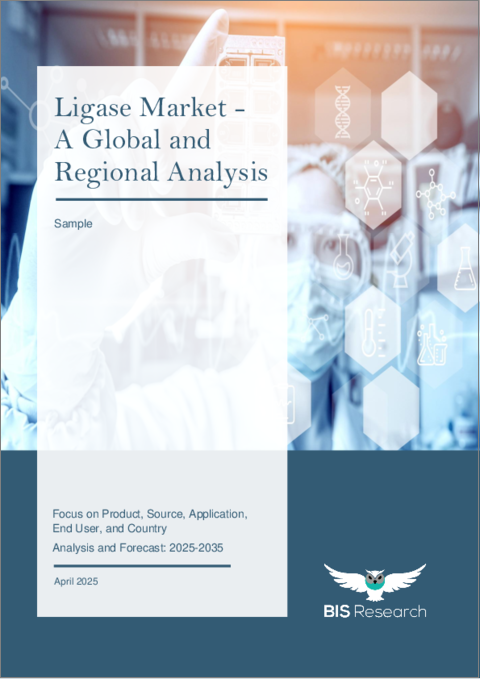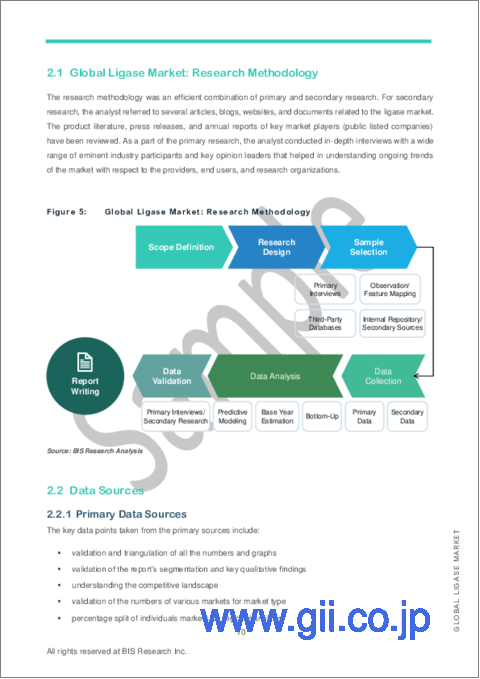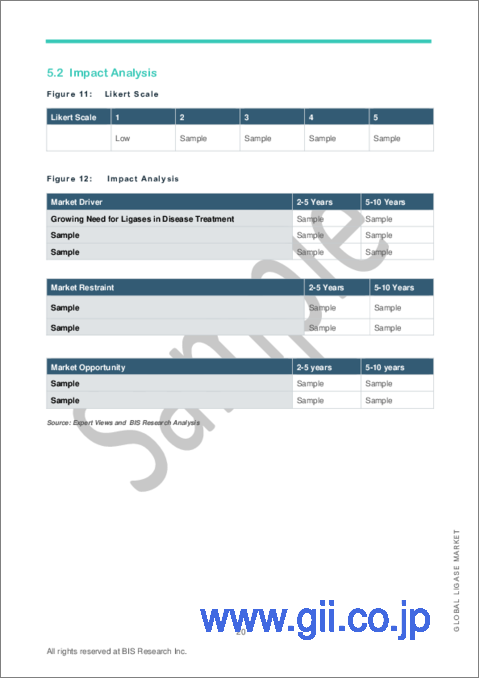|
|
市場調査レポート
商品コード
1711585
リガーゼ市場- 世界および地域別分析:製品別、由来別、用途別、エンドユーザー別、国別 - 分析と予測(2025年~2035年)Ligase Market - A Global and Regional Analysis: Focus on Product, Source, Application, End User, and Country - Analysis and Forecast, 2025-2035 |
||||||
カスタマイズ可能
|
|||||||
| リガーゼ市場- 世界および地域別分析:製品別、由来別、用途別、エンドユーザー別、国別 - 分析と予測(2025年~2035年) |
|
出版日: 2025年04月23日
発行: BIS Research
ページ情報: 英文 110 Pages
納期: 1~5営業日
|
全表示
- 概要
- 図表
- 目次
世界のリガーゼの市場規模は、2025年から2035年までの予測期間中に5.61%のCAGRで拡大すると予測されています。
世界のリガーゼ市場の成長は、世界レベルでの感染症や遺伝性疾患の有病率の増加、酵素ベースの診断検査に対する意識の高まり、研究開発を実行するための多くの資金提供などの要因によって牽引されると予測されます。
世界のリガーゼ市場は、疾患検出用の幅広いリガーゼ製品に関する研究開発活動の著しい増加とともに急速に進展しており、ヘルスケアにおけるリガーゼの重要性を際立たせています。リガーゼ酵素は、分子診断学的アプローチにおいて重要な役割を担っており、標的治療薬の安全かつ効果的な応用を保証しています。世界のリガーゼ市場の大半の企業は、ライゲーションキットや酵素を含む製品を提供しています。
酵素ベースの分子診断のための研究開発投資の増加は、リガーゼ市場における主要な機会の一つです。複数の診断薬・製薬企業が共同で医薬品開発に取り組んでおり、効率的な診断、治療法の選択、投与量の選択、治療モニタリングなどを可能にするため、リガーゼを複数の疾患適応症の治療手段として使用しています。
リガーゼの開発には、特定のDNAまたはRNA配列を検出し定量化するために、いくつかの技術が採用されています。このリガーゼ市場領域は、リガーゼ連鎖反応(LCR)、リガーゼ検出反応(LDR)、次世代シーケンシング(NGS)、リピート拡大検出(RED)、ローリングサークル増幅(RCA)、近接ライゲーションアッセイ(PLA)、分子クローニング、ライゲーション媒介PCR、変異検出、および創薬ターゲットなどのその他のアプリケーションにセグメント化されています。
- リガーゼ連鎖反応(LCR):LCRはポリメラーゼ連鎖反応(PCR)とは対照的な増幅プロセスで、2つのプローブや異なる粒子を結合させるための耐熱性リガーゼを含み、標準的なPCRサイクリング別増幅されます。
- リガーゼ検出反応(LDR):LDRはリガーゼ連鎖反応(LCR)に依存する手法で、標的DNAの1本鎖に1対の相補的プローブを結合させる。この手法では、ミスマッチプローブのライゲーションを区別できる高忠実度ベースの耐熱性DNAリガーゼを利用します。
- 次世代シーケンシング(NGS):次世代シーケンシングでは、DNAリガーゼを用いてDNA配列の特定位置にヌクレオチドが存在するかどうかを同定します。このシーケンシングの役割は、DNAリガーゼが塩基を紛れもない形で同定し、統合する能力に依存しています。
- ライゲーション媒介PCR:Ligation mediated PCRのプロセスは、巨大な分子、例えば、増幅された酵母人工染色体(YAC)からサブクローニングすることなく、プロトタイプのシークエンシングテンプレートを生成することを可能にします。
製品セグメント別では、T4 DNAリガーゼが支配的であると予想されます。これは、T4 DNAリガーゼの使用量が増加しているためであり、エンドユーザーにキットや酵素を提供するサプライヤーの間では、T4 DNAリガーゼが最も一般的に使用されています。
世界のリガーゼ市場は大腸菌由来が独占的です。大腸菌由来リガーゼは、細胞内に導入される前に分子の組み換え末端を結合するために一般的に使用されるリガーゼだからです。T4 RNAリガーゼ、T4 DNAリガーゼ、大腸菌DNAリガーゼ、塩T4 DNAリガーゼなどの製品は、大腸菌から豊富に得られます。
分子クローニングプロセスは用途別セグメントを独占し、NGSは世界のリガーゼ市場における新たな診断に用いられています。この手順の利用が増加しているのは、DNA断片の組み換えの容易さと速度を向上させるために、分子クローニングに該当する様々なクローニング技術が生み出されたためです。
リガーゼ酵素の診断用途の特定に焦点を当てた調査研究を実施する研究機関が特に多いため、世界のリガーゼ市場では、研究機関および研究機関がエンドユーザーセグメントを独占しています。
世界のリガーゼ市場における最近の動向
- 2022年1月、ArcticZymes Technologiesは、ArcticZymes R2DTM Ligase、IsoPol BST+High Concentration Glycerol FREE、M-SAN HQ ELISA Kit、M-SAN HQなどの新製品を発売しました。
- 2022年4月、Codexis, Inc.とMolecular Assemblies, Inc.が、酵素のエンジニアリングとDNAの酵素合成のための差別化されたコスト効率の高いソリューションの提供で提携しました。
- 2022年5月、QIAGENはポーランドのグダニスクに拠点を置くライフサイエンス産業向け組換え酵素メーカーBLIRT e.u.の株式の96%を取得しました。この買収は、酵素・試薬事業にさらなる成長の可能性をもたらすために行われました。
- 2021年7月、Merckはダルムシュタットの世界本社に2億8,250万米ドルを投資しました。Merckはヘルスケア事業部門のための新しいトランスレーショナルサイエンスセンターと新しいラーニングセンターの建設に取り組んでいます。
製品/イノベーション戦略:本レポートでは、リガーゼキットと酵素の両方を製品ベース企業のものとみなしています。これらの企業は、研究開発の成功を商業的な臨床環境に結びつけるため、重要な事業戦略に積極的に取り組んでいます。
成長/マーケティング戦略:超並列シーケンシングとその用途の爆発的な普及により、ヘルスケアの全分野、特に酵素ベースの分子診断学が影響を受けています。リガーゼ市場の主要コンポーネントは、多様なリガーゼベースの製品とライゲーションキットで構成され、一般に検査会社や検査サービス自体が購入します。本レポートでは、検査に使用されるアプリケーションを考慮した価格分析とともに、ワークフロー全体を詳しく解説しています。
競合戦略:世界のリガーゼ市場における主要企業プロファイルを分析、プロファイリングしています。さらに、世界のリガーゼ市場で事業を展開する参入企業の詳細な競合ベンチマーキングを実施し、明確な市場情勢を提示することで、参入企業が互いにどのようにスタックしているかを読者が理解できるようにしています。さらに、パートナーシップ、契約、提携などの包括的な競合戦略は、読者が市場の未開拓の収益ポケットを理解するのに役立ちます。
当レポートでは、世界のリガーゼ市場について調査し、市場の概要とともに、製品別、由来別、用途別、エンドユーザー別、国別の動向、および市場に参入する企業のプロファイルなどを提供しています。
目次
エグゼクティブサマリー
第1章 市場概要
- 概要
- 主な動向
- 特許分析
- 規制分析
- 価格分析
第2章 市場力学
- 概要
- 影響分析
- 市場促進要因
- 市場抑制要因
- 市場機会
第3章 世界のリガーゼ市場:競合情勢
- 概要
- 企業戦略
- ビジネス戦略
- 市場シェア分析
第4章 世界のリガーゼ市場、製品タイプ別、(100万米ドル)、2023年~2035年
- 概要
- クイックリガーゼ
- T4 DNAリガーゼ
- 大腸菌DNAリガーゼ
- Tth DNAリガーゼ
- T4 RNAリガーゼ
- Pfu DNAリガーゼ
- その他
第5章 世界のリガーゼ市場、由来別、(100万米ドル)、2023年~2035年
- 概要
- 古細菌
- 大腸菌
- サーマス・サーモフィラス
- ピロコッカス・フリオサス
- その他
第6章 世界のリガーゼ市場、用途別、(100万米ドル)、2023年~2035年
- 概要
- リガーゼ連鎖反応(LCR)
- リガーゼ検出反応(LDR)
- 次世代シーケンシング(NGS)
- 繰り返し拡張検出(RED)
- ローリングサークルアンプ(RCA)
- 近接ライゲーションアッセイ(PLA)
- 分子クローニング
- ライゲーション介在PCR
- 突然変異検出
- その他
第7章 世界のリガーゼ市場、エンドユーザー別、(100万米ドル)、2023年~2035年
- 概要
- 研究室および研究機関
- 製薬会社およびバイオ医薬品会社
- 診断検査室
- その他
第8章 世界のリガーゼ市場、地域別、(100万米ドル)、2023年~2035年
- 概要
- 北米
- 米国
- カナダ
- 欧州
- ドイツ
- フランス
- 英国
- イタリア
- スペイン
- オランダ
- その他
- アジア太平洋
- 中国
- 日本
- インド
- オーストラリア
- 韓国
- その他
- ラテンアメリカ
- ブラジル
- メキシコ
- その他
- 中東・アフリカ
- 中東
- アフリカ
第9章 企業プロファイル
- Agilent Technologies, Inc.
- ArcticZymes Technologies ASA
- BD
- Bio-Rad Laboratories, Inc.
- Codexis, Inc.
- F. Hoffmann-La Roche Ltd.
- Inspiralis Limited, Inc.
- Merck KGaA
- New England Biolabs(UK)Ltd.
- Promega Corporation
- QIAGEN N.V.
- SBS Genetech
- Takara Bio Inc.
- Thermo Fisher Scientific, Inc.
- Emerging Companies
List of Figures
- Figure: Global Ligase Market, Dynamics Impact Analysis
- Figure: Global Ligase Market Coverage
- Figure: Global Ligase Market, Key Trends, Impact Analysis, 2023-2035
- Figure: Global Ligase Market, Patent Analysis, January 2022-March 2025
- Figure: Global Ligase Market, Competitive Landscape, January 2022-March 2025
List of Tables
- Table: Global Ligase Market Dynamics, Impact Analysis
- Table: Global Ligase Market (by Product Type), $Million, 2023-2035
- Table: Global Ligase Market (by Source Type), $Million, 2023-2035
- Table: Global Ligase Market (by Application), $Million, 2023-2035
- Table: Global Ligase Market (by End User), $Million, 2023-2035
- Table: Global Ligase Market (Region), $Million, 2023-2035
Global Ligase Market Industry Overview
The global ligase market is expected to grow at a CAGR of 5.61% during the forecast period from 2025 to 2035. The growth in the global ligase market is expected to be driven by factors such as the increasing prevalence of infectious and genetic diseases on a global level, rising awareness of enzyme based diagnostic testing and significant number of funding for executing research and development.
Market Lifecycle Stage
The global ligase market is progressing rapidly with a significant increase in the research and development activities pertaining to a wide range of ligase product for disease detection, accentuating their criticality in healthcare. Ligase enzyme has a critical role in the molecular diagnostics approach, as it ensures the safe and effective application of targeted therapeutics. Most of the players in the global ligase market offer products encompassing the ligation kits and enzymes.
Increasing investments in the R&D for enzyme-based molecular diagnostics is one of the major opportunities in the ligase market. Several diagnostics and pharmaceutical companies are working collaboratively on drug development and using ligase as a therapeutic means for applications in several disease indications in order to enable efficient diagnosis, treatment selection, dosage selection, and treatment monitoring.
Impact
Several techniques are employed in the development of ligase utilization to detect and quantify specific DNA or RNA sequences. This ligase market space has been segmented into applications that includes ligase chain reaction (LCR), ligase detection reaction (LDR), next-generation sequencing (NGS), repeat expansion detection (RED), rolling circle amplification (RCA), proximity ligation assay (PLA), molecular cloning, ligation mediated PCR, mutation detection, and other application such as drug target. Some of these technologies are described briefly as follows:
- Ligase chain reaction (LCR): LCR is an amplification process that contrasts with polymerase chain reaction (PCR), which includes a thermostable ligase to join two probes or different particles together, which can then be amplified by standard PCR cycling.
- Ligase detection reaction (LDR): LDR is a ligase chain reaction (LCR) dependent methodology which that involves a single pair of complementary probes to one strand of targeted DNA. This technique utilizes a high fidelity based thermostable DNA ligase that can distinguish against the ligation of mismatched probes.
- Next-generation sequencing (NGS): In next-generation sequencing, DNA ligase is used to identify the presence of the nucleotide at a specific position in a DNA sequence. The role of this sequencing depends upon the ability of DNA ligase to identify and consolidate bases in an unmistakable way.
- Ligation mediated PCR: The process of ligation mediated PCR allows to generate prototypical sequencing templates without subcloning from huge molecules, for example-., amplified yeast artificial chromosomes (YACs).
Market Segmentation:
Segmentation 1: by Product
- Quick Ligase
- T4 DNA ligase
- E. coli DNA Ligase
- Tth DNA Ligase
- T4 RNA Ligase
- Pfu DNA Ligase
- Others
The global ligase market in the products segment is expected to be dominated by T4 DNA ligase. This is due to an increased usage of T4 DNA ligase, and it is the most commonly used ligase type among suppliers offering kits and enzymes to their end users.
Segmentation 2: by Source
- Archaebacterium
- Escherichia coli
- Thermus thermophilus
- Pyrococcus furiosus
- Others
The global ligase market is dominated by the Escherichia coli source as it is a commonly used ligase to join recombinant ends of molecules before they are introduced into the cell. Products like T4 RNA ligase, T4 DNA ligase, E. coli DNA ligase, and salt T4 DNA ligase are obtained from Escherichia coli in abundance.
Segmentation 3: by Application
- Ligase Chain Reaction (LCR)
- Ligase Detection Reaction (LDR)
- Next-Generation Sequencing (NGS)
- Repeat Expansion Detection (RED)
- Rolling Circle Amplification (RCA)
- Proximity Ligation Assay (PLA)
- Molecular Cloning
- Ligation Mediated PCR
- Mutation Detection
- Others
The molecular cloning process dominates the application segment and NGS is the emerging diagnostic application in the global ligase market. The increase in the utilization of this procedure is due to various cloning techniques that have been created that fall under molecular cloning to improve the ease and speed at which DNA fragments can be recombined.
Segmentation 4: by End User
- Research Laboratories and Institutions
- Pharmaceutical and Biopharmaceutical Companies
- Diagnostic Laboratories
- Others
The research laboratories and institutions dominate the end-user segment in the global ligase market as research laboratories, particularly are most involved in carrying out the research studies that are focused on the identification of understanding the diagnostic application of ligase enzyme.
Recent Developments in Global Ligase Market
- In January 2022, ArcticZymes Technologies launched new products such as ArcticZymes R2DTM Ligase, IsoPol BST+ High Concentration Glycerol FREE and M-SAN HQ ELISA Kit and M-SAN HQ
- In April 2022, Codexis, Inc. and Molecular Assemblies, Inc., partnered to engineer enzymes and deliver differentiated and cost-effective solutions for the enzymatic synthesis of DNA.
- In May 2022, QIAGEN acquired majority stake of 96% in BLIRT e.u.., a manufacturer of recombinant enzymes for the life science industry based in Gdansk, Poland. The acquisition was carried out to bring companies capabilities to create additional growth prospects to their enzymes and reagents business.
- In July 2021, Merck invested $282.5 million at its global headquarters in Darmstadt. Company is involved in building a new translational science center for its healthcare business sector as well as a new learning center.
Demand - Drivers and Limitations
Following are the demand drivers for the global ligase market:
- Growing need for Ligases in Disease Treatment
- Rising Incidence of Diseases such as Cancer and Genetic Disorders
- Rising Focus of Researchers on Non-Toxic Biocatalyst
The market is expected to face some limitations too due to the following challenges:
- High Reception Costs Involving Small and Medium Enterprises
- Variation in the Ability of Ligase to Repair
How Can This Report Add Value to an Organization?
Product/Innovation Strategy: The report considers ligase kits and enzymes both from the product-based companies. These companies are actively involved in undertaking significant business strategies to translate success in research and development into the commercial clinical setting.
Growth/Marketing Strategy: Owing to the explosion of massively parallel sequencing and its applications, all areas of healthcare have been affected, particularly enzyme-based molecular diagnostics. The key components in the ligase market consists of diverse range of ligase-based products and ligation kits, generally purchased by the testing companies and the testing services themselves. The entire workflow is well explained in the report along with pricing analysis considering the applications that are used in testing.
Competitive Strategy: Key players in the global ligase market analysed and profiled in the study, consisting of both products-based companies as well as few emerging companies. Moreover, a detailed competitive benchmarking of the players operating in the global ligase market has been done to help the reader understand how players stack against each other, presenting a clear market landscape. Additionally, comprehensive competitive strategies such as partnerships, agreements, and collaborations will aid the reader in understanding the untapped revenue pockets in the market.
Key Market Players and Competition Synopsis
The companies that are profiled have been selected based on inputs gathered from primary experts and analyzing company coverage, product portfolio, and market penetration.
The leading top segment players include ligase enzyme manufacturers that offers major products such as T4 DNA ligase, and E.coli DNA ligase, quick ligase, Pfu DNA ligase, T4 RNA ligase in the market.
Some of the prominent names established in this market are:
- Agilent Technologies, Inc.
- ArcticZymes Technologies ASA
- BD
- Bio-Rad Laboratories, Inc.
- Codexis, Inc.
- F. Hoffmann-La Roche Ltd.
- Merck KGaA
- New England Biolabs (UK) Ltd.
- Promega Corporation
- QIAGEN N.V.
- SBS Genetech
- Takara Bio Inc.
- Thermo Fisher Scientific, Inc.
Table of Contents
Executive Summary
Scope and Definition
Market/Product Definition
Inclusion and Exclusion
Key Questions Answered
Analysis and Forecast Note
Research Methodology
1. Market Overview
- 1.1 Overview
- 1.2 Key Trends
- 1.3 Patent Analysis
- 1.4 Regulatory Analysis
- 1.5 Pricing Analysis
2. Market Dynamics
- 2.1 Overview
- 2.1.1 Impact Analysis
- 2.2 Market Drivers
- 2.3 Market Restraints
- 2.4 Market Opportunities
3. Global Ligase Market: Competitive Landscape
- 3.1 Overview
- 3.2 Corporate Strategies
- 3.2.1 Mergers and Acquisitions
- 3.2.2 Synergistic Activities
- 3.2.3 Business Expansions and Funding
- 3.3 Business Strategies
- 3.3.1 Product Launches and Approvals
- 3.3.2 Publications
- 3.3.3 Licenses and Agreements
- 3.3.4 Other Activities
- 3.4 Market Share Analysis
4. Global Ligase Market (by Product Type), ($Million), 2023-2035
- 4.1 Overview
- 4.2 Quick Ligase
- 4.3 T4 DNA Ligase
- 4.4 E. coli DNA Ligase
- 4.5 Tth DNA Ligase
- 4.6 T4 RNA Ligase
- 4.7 Pfu DNA Ligase
- 4.8 Others
5. Global Ligase Market (by Source Type), ($Million), 2023-2035
- 5.1 Overview
- 5.2 Archaebacterium
- 5.3 Escherichia coli
- 5.4 Thermus thermophilus
- 5.5 Pyrococcus furiosus
- 5.6 Others
6. Global Ligase Market (by Application), ($Million), 2023-2035
- 6.1 Overview
- 6.2 Ligase Chain Reaction (LCR)
- 6.3 Ligase Detection Reaction (LDR)
- 6.4 Next-Generation Sequencing (NGS)
- 6.5 Repeat Expansion Detection (RED)
- 6.6 Rolling Circle Amplification (RCA)
- 6.7 Proximity Ligation Assay (PLA)
- 6.8 Molecular Cloning
- 6.9 Ligation Mediated PCR
- 6.10 Mutation Detection
- 6.11 Others
7. Global Ligase Market (by End User), ($Million), 2023-2035
- 7.1 Overview
- 7.2 Research Laboratories and Institutions
- 7.3 Pharmaceutical and Biopharmaceutical Companies
- 7.4 Diagnostic Laboratories
- 7.5 Other End Users
8. Global Ligase Market (by Region), ($Million), 2023-2035
- 8.1 Overview
- 8.2 North America
- 8.2.1 U.S.
- 8.2.2 Canada
- 8.3 Europe
- 8.3.1 Germany
- 8.3.2 France
- 8.3.3 U.K
- 8.3.4 Italy
- 8.3.5 Spain
- 8.3.6 Netherlands
- 8.3.7 Rest-of-Europe
- 8.4 Asia-Pacific
- 8.4.1 China
- 8.4.2 Japan
- 8.4.3 India
- 8.4.4 Australia
- 8.4.5 South Korea
- 8.4.6 Rest-of-Asia-Pacific (RoAPAC)
- 8.5 Latin America
- 8.5.1 Brazil
- 8.5.2 Mexico
- 8.5.3 Rest-of-Latin America
- 8.6 Middle East and Africa
- 8.6.1 Middle East
- 8.6.2 Africa
9. Company Profiles
- 9.1 Agilent Technologies, Inc.
- 9.1.1 Company Overview
- 9.1.2 Product Portfolio
- 9.1.3 Target Customers/End Users
- 9.1.4 Analyst View
- 9.2 ArcticZymes Technologies ASA
- 9.2.1 Company Overview
- 9.2.2 Product Portfolio
- 9.2.3 Target Customers/End Users
- 9.2.4 Analyst View
- 9.3 BD
- 9.3.1 Company Overview
- 9.3.2 Product Portfolio
- 9.3.3 Target Customers/End Users
- 9.3.4 Analyst View
- 9.4 Bio-Rad Laboratories, Inc.
- 9.4.1 Company Overview
- 9.4.2 Product Portfolio
- 9.4.3 Target Customers/End Users
- 9.4.4 Analyst View
- 9.5 Codexis, Inc.
- 9.5.1 Company Overview
- 9.5.2 Product Portfolio
- 9.5.3 Target Customers/End Users
- 9.5.4 Analyst View
- 9.6 F. Hoffmann-La Roche Ltd.
- 9.6.1 Company Overview
- 9.6.2 Product Portfolio
- 9.6.3 Target Customers/End Users
- 9.6.4 Analyst View
- 9.7 Inspiralis Limited, Inc.
- 9.7.1 Company Overview
- 9.7.2 Product Portfolio
- 9.7.3 Target Customers/End Users
- 9.7.4 Analyst View
- 9.8 Merck KGaA
- 9.8.1 Company Overview
- 9.8.2 Product Portfolio
- 9.8.3 Target Customers/End Users
- 9.8.4 Analyst View
- 9.9 New England Biolabs (UK) Ltd.
- 9.9.1 Company Overview
- 9.9.2 Product Portfolio
- 9.9.3 Target Customers/End Users
- 9.9.4 Analyst View
- 9.10 Promega Corporation
- 9.10.1 Company Overview
- 9.10.2 Product Portfolio
- 9.10.3 Target Customers/End Users
- 9.10.4 Analyst View
- 9.11 QIAGEN N.V.
- 9.11.1 Company Overview
- 9.11.2 Product Portfolio
- 9.11.3 Target Customers/End Users
- 9.11.4 Analyst View
- 9.12 SBS Genetech
- 9.12.1 Company Overview
- 9.12.2 Product Portfolio
- 9.12.3 Target Customers/End Users
- 9.12.4 Analyst View
- 9.13 Takara Bio Inc.
- 9.13.1 Company Overview
- 9.13.2 Product Portfolio
- 9.13.3 Target Customers/End Users
- 9.13.4 Analyst View
- 9.14 Thermo Fisher Scientific, Inc.
- 9.14.1 Company Overview
- 9.14.2 Product Portfolio
- 9.14.3 Target Customers/End Users
- 9.14.4 Analyst View
- 9.15 Emerging Companies
- 9.15.1 Tinzyme Ltd.
- 9.15.2 Hotspot Therapeutics
- 9.15.3 Nurix Therapeutics
- 9.15.4 Vividion Therapeutics





